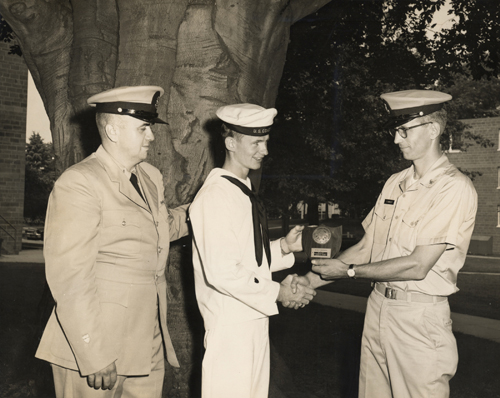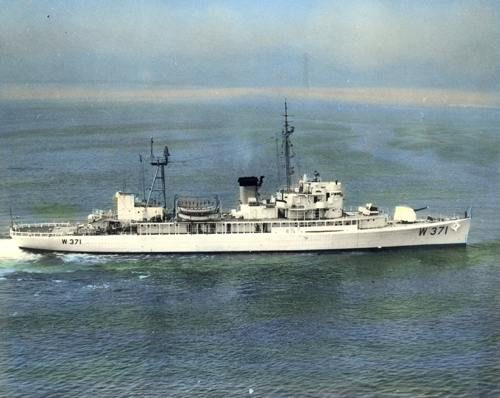A chef’s career gets under way in a (sometimes rolling) cutter galley

As I stood on the dock in Greenport watching the U.S. Coast Guard barque Eagle come into port for the recent Maritime Festival, I was suddenly full of memories of a time 45 years ago when I was a cook in the U.S. Coast Guard.
My very first assignment out of boot camp was the 311-foot Coast Guard cutter Mackinac. It was based out of New York Harbor and patrolled the Atlantic from Greenland to Cuba. On my first patrol, in September 1966, we were headed to Guantanamo Bay for training with the Navy when we received an SOS from a ship that had lost power in a raging storm off the Florida Keys.
The storm was Hurricane Inez, one of the most destructive storms on record, causing over 1,000 deaths in the Caribbean. To rescue the ship we headed into giant 30-foot swells and withstood 80 mph winds. The screws of our ship were coming out of the water as the bow was buried in the waves.
In the galley, it was too dangerous to cook hot food, so the crew ate cold cuts and bread. This voyage ended safely and we were able to reach the disabled ship and restore its power. But our ship rarely sailed in calm water, as our mission was to man weather stations and be nearby to help ships and airplanes in distress.
Cooking in this environment required holding on with one hand and cooking with the other. Knives and utensils were always placed on a wet towel to prevent sliding. The galley of the Mackinac was located on the main deck, extending the entire width of the ship, with doors on either side to enhance ventilation. It was equipped with a six-burner stove, a large flat-top griddle, a stack oven, two steam jacketed (trunnion) kettles and a deep fryer with a 12-inch rim around it to prevent splashing. All our equipment was electric, as is common on most ships.

Surprisingly, much of our cooking was done from scratch. We made cakes and bread and used fresh produce as long as it lasted into the five-week patrols. In rough seas we would have to make some recipe adjustments, such as reducing the liquid called for in chocolate cake to keep it from rolling out of the pan in the oven. At breakfast we often had to turn the griddle up to 450 degrees so that when we cooked eggs over easy the whites would set immediately, allowing the yolk to roll back and forth while it cooked.
But we cooked some very good food, mostly following the recipe cards developed for the Navy and Marines in 1963. The crew ate meals on the mess deck located below the galley, where tables with benches were bolted to the floor and the food was sent down in a dumbwaiter. Our walk-in freezer and dry stores were located in the hold three decks below and required treacherous trips up and down the ladders.
After a year aboard ship I went to the Coast Guard Commissary School for 16 weeks and was then assigned to the Short Beach lifeboat station near Jones Beach. The station had 21 men and three rescue boats. It was very different from the ship in that I was able to write my own menus and purchase ingredients from local sources.
On weekends during the boating season we had many Coast Guard auxiliary officers on hand to help with law enforcement and rescue operations. These people would often have clambakes on the beach and it introduced me to Long Island’s wonderful bounty of seafood.
After a year at this station I was transferred to Governor’s Island, where I became a food service instructor at the Commissary School. This school consisted of intense four-week segments including classroom theory, meat handling, baking and production, which had us serving meals to the other schools on the island. I was able to teach all four segments and discovered later in my career as a chef that these lessons in the fundamentals of cooking were a great asset. At the time it was just another duty station, although a beautiful one, as my wife and I actually lived on Governor’s Island during the last year of my enlistment.
Here are some updated, small-quantity versions of Coast Guard and Navy classics.
Creamed Beef (‘S.O.S.’)
Spray a large sauté pan with no-stick and place it on medium high heat. Add 1 pound of ground chuck and break it up with a spoon as it cooks. While it is still pink, add 1 chopped onion, 1 teaspoon coarse salt, 1/2 teaspoon pepper and 1/4 teaspoon nutmeg. As the onions cook, add 1/4 cup flour and stir it into the meat to form a roux. Slowly add 2 cups milk, reduce the heat and let it simmer for 15 minutes. Taste for seasoning.
This dish can be served over toast or buttermilk biscuits.
Serves 4-6.
Stuffed Peppers (‘S.I.S.’)
Begin by making a stewed tomato sauce. Trim the ends off of 6 plum tomatoes and cut them into 1/4-inch dice. Place them in a saucepan along with 1/2 cup chopped celery, 1/2 cup chopped onion and 1/2 cup finely chopped green pepper. Season with 1/4 cup chopped fresh basil, 1 tablespoon fresh oregano, 1 tablespoon sugar, 1 teaspoon coarse salt, 1/2 teaspoon pepper and 1/4 teaspoon red pepper flakes. Let the mixture simmer for 20 minutes and add 1 small can of tomato sauce.
Cut the tops off of 6 bell peppers. For appearance, use 2 green, 2 red and 2 yellow peppers. Cut out the insides and cut the bottoms so that they stand up. Combine in a large bowl 1 pound of ground meatloaf meat (beef, pork, veal) and 2 chopped chorizo sausages. Add to this 1 cup chopped onion, 2 tablespoons catsup, 1 tablespoon chopped oregano, 2 teaspoons salt and 1 teaspoon pepper.
Blanch 1 cup brown rice in boiling water for 15 minutes, drain and add to the meat mixture. Stuff this mixture into the peppers and place them in a deep casserole. Pour the sauce over them, cover and bake in a 350-degree oven for 1 1/2 hours.
Serves 6.
Old-Fashioned Navy Bean Soup
Purchase 1 pound of dried navy beans and rinse them under cold water. Place them in a soup pot and cover with 2 quarts water. Bring them to a boil and turn off the heat. Cover the pot and let rest for 1 hour.
Meanwhile, dice 4 ounces of salt pork and cook at medium heat in a Dutch oven or heavy-bottomed soup pot. When it has turned brown and released its fat, add 1 chopped onion, 2 chopped ribs of celery and 2 chopped carrots. Continue cooking and add 2 tablespoons fresh chopped oregano and 1 tablespoon chopped fresh thyme.
Drain the navy beans, saving 2 cups of the cooking liquid. Add the beans to the soup pot along with 4 cups chicken stock and bring to a boil. Add 1 bay leaf, 1 can (15 ounces) of chopped tomatoes and a smoked ham hock. Season with 1 teaspoon black pepper and 1/4 teaspoon red pepper flakes. Cook uncovered at simmering temperature until beans are tender, adding the reserved liquid as the broth evaporates. Total cooking time should be about 1 1/2 hours.
Remove the ham hock, cut off the meat and add it to the soup. Add 1 tablespoon red wine vinegar and a little salt to taste. Garnish with chopped parsley.
Serves 6-8.
John Ross, a chef and author, has been an active part of the North Fork food and wine community for more than 35 years. Email: [email protected].



